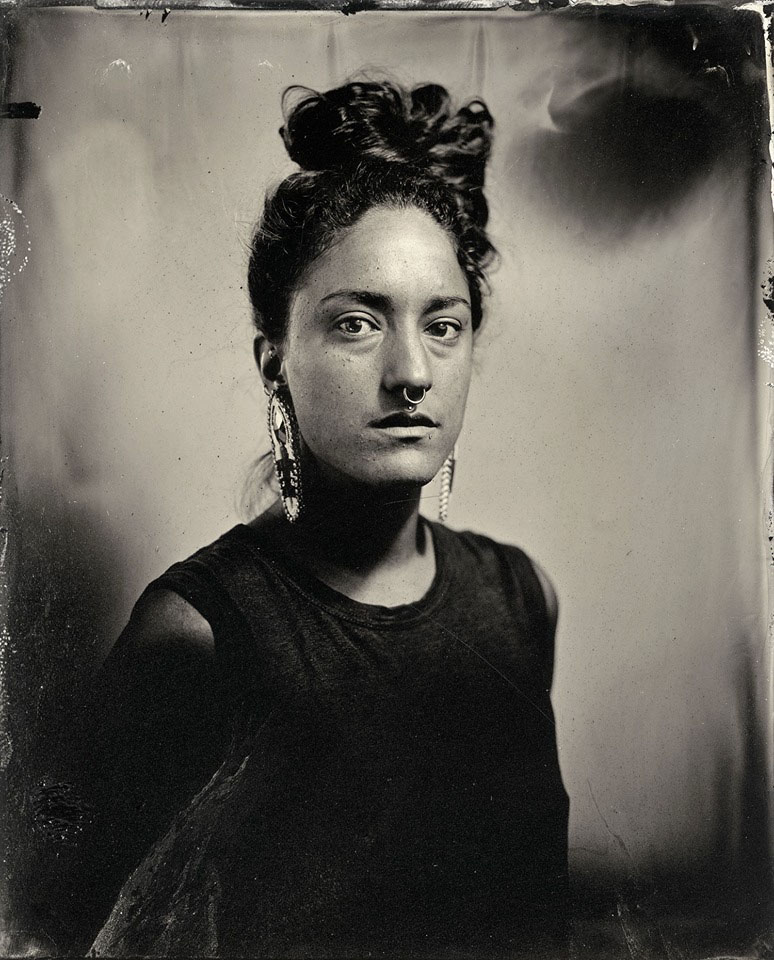Kali Spitzer | “An Exploration of Resilience and Resistance”
An Exploration of Resilience and Resistance is about identity, culture, strength, vulnerability, and love. In this series, artist Kali Spitzer is photographing her community of diverse BIPOC (Black, Indigenous, & People of Colour) in all of our complexity and beauty. While challenging pre-conceived notions of race, gender and sexuality, Spitzer focusses on our Queer, 2S, Trans & Non-Binary kin to touch on how we can become more empathic, empowered people despite the hardships that we have endured.
Curator’s Note: Each photograph is accompanied by an audio piece (below), intended to be listened to while viewing the photograph.
Angel Mills
Click the image to expand and zoom in.
Listen to Angel Mills’s interview below.
Erena Baker Arapere Ūkaipõ
Click the image to expand and zoom in.
Listen to Erena Baker Arapere Ūkaipõ’s interview below.
Spitzer uses tintype photographs to create representions of the people she photographs. Tintype or ferrotype photography was a product of the late 1800s and was most popular during the US Civil War. The medium persisted into the 20th century at fairs and carnivals as tourist photography. In the 21st century, it has been revived as novelty or art photography. The tintype was the first real populist form of photography, making photographs available to working class people through popular events and gatherings.
It’s hard to look at tintypes now and not be thrust back into the colonial era so that Spitzer’s photographs look both modern and historic. Many of them look like they could have been shot at a rodeo or a powwow, retaining that populist leaning that made the medium well known at their inception. Spitzer is subversive and strategic.
“Every photograph, every person, has a story to tell, and I am telling it through their portrait. When I photograph a person, I aim to create the most honest image of them. I believe that each image I make is a collaboration between the person I am photographing and myself. I wouldn’t be able to create the images I do without trust; trust an essential element of my work. There is an urgency to my work. I am part of a generation that is hugely affected by Residential Schools and Settler Colonialism. We are in a race against time as we are losing many of our elders, along with our stories, language, and culture. It is a struggle for our generation and for those to come. We need to spend time listening to our elders and learning from them. We struggle with holding onto our identities and re-discovering ourselves in this era of Settler Colonialism.”
— Kali Spitzer
ABOUT KALI SPITZER

“Indigenous Femme Queer Photographer Kali Spitzer ignites the spirit of our current unbound human experience with all the complex histories we exist in, passed down through the trauma inflicted/received by our ancestors. Kali’s photographs are intimate and unapologetic and make room for growth and forgiveness while creating a space where we may share the vulnerable and broken parts of our stories which are often overlooked, or not easy to digest for ourselves or society.” — Ginger Dunnill, Creator and Producer of Broken Boxes Podcast.
Kali Spitzer is a photographer living on the Traditional Unceded Lands of the Tsleil-Waututh, Skxwú7mesh and Musqueam peoples. The work of Kali embraces the stories of contemporary BIPOC, Queer and trans bodies, creating representation that is self determined. Kali’s collaborative process is informed by the desire to rewrite the visual histories of indigenous bodies beyond a colonial lens. Kali is Kaska Dena from Daylu (Lower Post, british columbia) on her father’s side. Kali’s father is a survivor of residential schools and canadian genocide (sic). She is Jewish by way of Transylvania, Romania on her mother’s side. Kali’s heritage deeply influences her work as she focuses on cultural revitalization through her art, whether in the medium of photography, ceramics, tanning hides or hunting.
Mussi Cho
Soga Sénlá’
